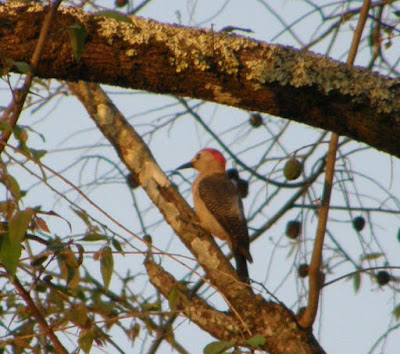

I think this is a clay coloured Robin. The reference book includes it among the thrushes. (Is the Robin I know from the UK also a member of the thrush family? Ornithologist needed!)
So I don't know if this is a relative of the red breasted robin or not. But it certainly behaves like one. This one spent most of its time on the ground, and it appears quite relaxed about my presence nearby. It's a regular visitor to the garden.
Another regular visitor is a woodpecker - actually, a pair of woodpeckers. My friends here in Belize advise us to do all we can to chase it away. There's a lot of wood in the structure of the house, and we don't want it subject to too much woodpecker attention! But they are strikingly attractive, both stationary and in flight.


My best guess is that this is a golden fronted woodpecker. There is a very similar bird, the red vented woodpecker, which has a shorter beak, a shorter tail, and yellow tufts near the beak. To my untrained eye, this looks to have quite long beak and tail, so golden fronted woodpecker it is.
We've seen a couple of these birds every day in the garden since we've been here - over three weeks. There are others we see walking to and from the market. But they only alight for a few seconds at a time. This one had the grace to wait long enough for me to go and get the camera.
In flight, the red head isn't what you notice; it has a distinctive swooping flight, with a flash of white rump feathers at every wingbeat.
Next post: parakeets.
 Once upon a time, when we still read bedtime stories with our children, one of the favourites was "But where is the green parrot?" by Wanda and Thomas Zacharias. Sadly, I believe it is out of print. But the green parrot lives on, in the form of the parakeets that come and roost some evenings in the tree just outside our garden.
Once upon a time, when we still read bedtime stories with our children, one of the favourites was "But where is the green parrot?" by Wanda and Thomas Zacharias. Sadly, I believe it is out of print. But the green parrot lives on, in the form of the parakeets that come and roost some evenings in the tree just outside our garden.




















